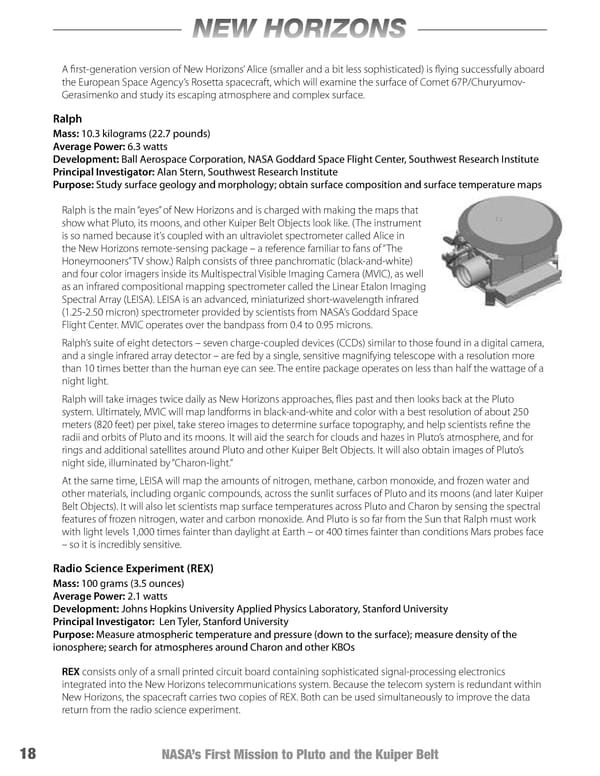NEW HORIZONS A first-generation version of New Horizons’ Alice (smaller and a bit less sophisticated) is flying successfully aboard the European Space Agency’s Rosetta spacecraft, which will examine the surface of Comet 67P/Churyumov- Gerasimenko and study its escaping atmosphere and complex surface. Ralph Mass: 10.3 kilograms (22.7 pounds) Average Power: 6.3 watts Development: Ball Aerospace Corporation, NASA Goddard Space Flight Center, Southwest Research Institute Principal Investigator: Alan Stern, Southwest Research Institute Purpose: Study surface geology and morphology; obtain surface composition and surface temperature maps Ralph is the main “eyes” of New Horizons and is charged with making the maps that show what Pluto, its moons, and other Kuiper Belt Objects look like. (The instrument is so named because it’s coupled with an ultraviolet spectrometer called Alice in the New Horizons remote-sensing package – a reference familiar to fans of “The Honeymooners” TV show.) Ralph consists of three panchromatic (black-and-white) and four color imagers inside its Multispectral Visible Imaging Camera (MVIC), as well as an infrared compositional mapping spectrometer called the Linear Etalon Imaging Spectral Array (LEISA). LEISA is an advanced, miniaturized short-wavelength infrared (1.25-2.50 micron) spectrometer provided by scientists from NASA’s Goddard Space Flight Center. MVIC operates over the bandpass from 0.4 to 0.95 microns. Ralph’s suite of eight detectors – seven charge-coupled devices (CCDs) similar to those found in a digital camera, and a single infrared array detector – are fed by a single, sensitive magnifying telescope with a resolution more than 10 times better than the human eye can see. The entire package operates on less than half the wattage of a night light. Ralph will take images twice daily as New Horizons approaches, flies past and then looks back at the Pluto system. Ultimately, MVIC will map landforms in black-and-white and color with a best resolution of about 250 meters (820 feet) per pixel, take stereo images to determine surface topography, and help scientists refine the radii and orbits of Pluto and its moons. It will aid the search for clouds and hazes in Pluto’s atmosphere, and for rings and additional satellites around Pluto and other Kuiper Belt Objects. It will also obtain images of Pluto’s night side, illuminated by “Charon-light.” At the same time, LEISA will map the amounts of nitrogen, methane, carbon monoxide, and frozen water and other materials, including organic compounds, across the sunlit surfaces of Pluto and its moons (and later Kuiper Belt Objects). It will also let scientists map surface temperatures across Pluto and Charon by sensing the spectral features of frozen nitrogen, water and carbon monoxide. And Pluto is so far from the Sun that Ralph must work with light levels 1,000 times fainter than daylight at Earth – or 400 times fainter than conditions Mars probes face – so it is incredibly sensitive. Radio Science Experiment (REX) Mass: 100 grams (3.5 ounces) Average Power: 2.1 watts Development: Johns Hopkins University Applied Physics Laboratory, Stanford University Principal Investigator: Len Tyler, Stanford University Purpose: Measure atmospheric temperature and pressure (down to the surface); measure density of the ionosphere; search for atmospheres around Charon and other KBOs REX consists only of a small printed circuit board containing sophisticated signal-processing electronics integrated into the New Horizons telecommunications system. Because the telecom system is redundant within New Horizons, the spacecraft carries two copies of REX. Both can be used simultaneously to improve the data return from the radio science experiment. 18 NASA’s First Mission to Pluto and the Kuiper Belt
 New Horizons Page 26 Page 28
New Horizons Page 26 Page 28